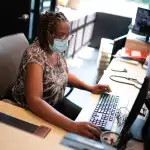September 21 marks Black Women’s Equal Pay Day, the day of the year on which the median earnings of a working Black woman will have caught up to the median 2021 annual earnings of a non-Latino White man. This year’s observance is over a month later than 2021’s appointed day, August 3.
Why is Black Women’s Equal Pay Day so much later than last year?
The change comes from a methodological switch: Equal Pay Today, the collaborative of nonprofits and advocacy groups that generally designates Equal Pay Day observances, decided to include part-time workers in its calculation.
Here’s how employment is usually measured in this country: The main data from agencies like the Bureau of Labor Statistics refers to non-agricultural labor (“nonfarm”) due to the difficulty tracking that kind of seasonal employment. Those nonfarm workers produce about 80 percent of the United States’ global domestic product, which all in all is a pretty good measure of the country’s economic status. People who usually work at least 35 hours a week are categorized as full-time employees.
In the past, this subset was what Equal Pay Today used to calculate observation days.
But dividing pay equity calculations by worker type reveals a stark difference. The median earnings for men who work full-time nonfarm jobs are 19 percent higher than those of women. But if you look at all nonfarm workers — full- and part-time — men’s median earnings are 30 percent higher than those of women.
The National Partnership for Women & Families, a nonprofit focused on racial and gender equity, said including seasonal workers, part-time employees and gig workers provides a more holistic view of pay equity issues. It also is more inclusive, as those positions are disproportionately held by women of color.
The 2021 data that this year’s Equal Pay Days reflect is also heavily impacted by the pandemic, when many jobs in fields that disproportionately employ women, such as leisure and hospitality and child care, were wiped out and slow to recover. An analysis of jobs recovery over 2021 showed many industries were starting to regain jobs lost in the pandemic last year, but the number of jobs in key industries like leisure and hospitality still lagged.
Including all workers accounts for people who are still feeling the fallout for unemployment from the pandemic. Women of color saw the largest pandemic-related dips in employment due to additional caregiving needs, job loss and lack of health benefits — based on an analysis of Census data, the National Partnership for Women & Families shows nearly 3.5 million women were atypically unrepresented in last year’s annual discussion of pay equity.
Why is including part-time workers important when discussing pay equity for Black women?
Including all types of work in pay equity analyses is particularly important for Black women, who disproportionately hold the types of jobs that pay the least and have the least amount of benefits such as sick time and caregiver leave. This isn’t due to differences in education — the gap persists across education levels — but rooted in racial discrimination.
Many workplace protection laws passed in the 20th century excluded Black women, explicitly or implicitly. For instance, the Fair Labor Standards Act of 1938 excluded domestic service workers, food processing workers and retail workers, among other occupations. Today, these continue to be the least-paid jobs — and data from the Bureau of Labor Statistics shows eight out of 10 of the lowest-paying job titles are dominated by women workers.
The lasting effects of segregation have a generational impact. Research from the American Association of University Women, a nonprofit dedicated to gender equity, points out that these factors mean that Black women workers — and people of color more broadly — were systemically blocked from earning equal pay for years. Pay disparities mean less money to take care of a family and pass on to future generations through things like housing or college savings.
How could pay transparency laws help close the pay gap for Black women?
A number of states and localities have in recent years passed pay transparency laws that require employers to share pay bands for job postings. Some recent laws seek to minimize compounding systemic bias by banning employers from asking about a candidate’s salary history. These laws are seen by advocates as an important step toward leveling the playing field for women of color in the workplace.
A lot of Americans don’t understand that the pay gap is actively happening in places where they work. Sixty-three percent of workers who make hiring decisions say Black women make just as much as White men at their organization, according to a 2018 LeanIn/SurveyMonkey poll. Forty-three percent of workers who make hiring decisions agreed that obstacles that made it hard for Black women to get ahead are largely gone.
Emily Martin, the vice president for education and workplace justice at the National Women’s Law Center, previously told The 19th that the culture of secrecy around pay makes it difficult to know when someone is experiencing pay discrimination.
More information in the public could help people advocate for themselves — and for systemic change.





